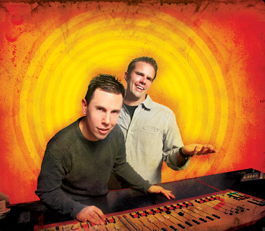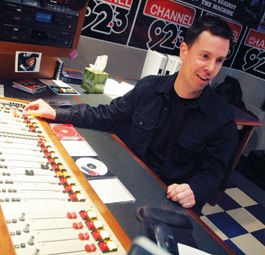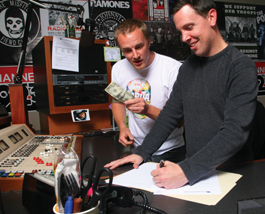home | metro silicon valley index | features | silicon valley | feature story

Photograph by Felipe Buitrago
GOOD LISTENERS: Channel 92.3 program director Michael Solari (left) and station manager Justin Wittmayer are championing a new style of alternative radio.
Air Warriors
How Channel 92.3 breaks rules and new bands by thinking like a college station.
By Steve Palopoli
'Hello, all my rebel radio friends. This is your friend Stephan Jenkins from Third Eye Blind. Late at night when I'm all alone, I ache for some kind of company. I ache to reach out. That's when I turn on Channel 92.3. New music for people who want to hear it. This is for the rebels. This is for everybody who wants radio to make them feel alive.'
INSIDE THE AIR ROOM of Channel 92.3, station manager Justin Wittmayer and program director Michael Solari are poring over new music. The South Bay alternative station's spacious studio, clustered next to sister stations KFOX-FM (98.5) and "La Preciosa" 104.9 FM in Clear Channel's San Jose offices, is sleek and hip-looking, not unlike its two top decision makers. Both have a scrubbed corporate polish to them. With their impeccable professional manners and fluency in marketspeak, it's not hard to see how they wrap Clear Channel bigwigs around their fingers.
In the fickle world of commercial radio, these guys are money, pure and simple—printed, bagged and stacked.
But just beneath the gloss that allows them to navigate the halls of radio's biggest conglomerate, there's something—dirty. Gritty. Something that calls to mind not the shiny, modern trappings of big radio, but the ratty, filthy couches of a college station.
It's not Solari's earring, or even the Misfits poster on the wall of the air room. It's the way they obsess over music. Especially Solari, who can talk about music with anyone and for any amount of time. He talks about it all day at work, and then, three to four nights a week, he goes to concerts around the South Bay or up in San Francisco and Oakland and engages people at those shows about what music they're listening to, and why. He's just as happy talking about the station's current stable of bands—like Green Day, Passion Pit, Death Cab for Cutie, Phoenix or Gaslight Anthem—as he is talking about the bands he grew up seeing—the Cure, Bad Religion, Descendents, Mother Love Bone.
And why shouldn't he be happy? Since he arrived at the station nicknamed "Channel" in 2007, the man's broken at least a dozen alternative bands on U.S. radio—as in, been the first to play them on any non-college-radio station in the country. Bands like the Ting Tings, Metric, Hockey, and most recently Matisyahu. He'd been playing the chasidic reggae performer for weeks already when the song "One Day" was adopted as the theme for the 2010 Vancouver Olympics. Rival alternative station Live 105 in San Francisco just added Matisyahu last week, well behind the Channel curve.
Right now, Solari is talking about doing that again as he plays Ladyhawke's single "My Delirium" for Wittmayer. The alter ego of New Zealand musician Phillipa Brown, Ladyhawke's sound fits in perfectly with the current rise of retro-'80s rock acts—on "My Delirium," her haunting vocals are laid over a slick chug of driving guitar. "In the U.S., outside of college radio, there's no major radio stations playing this right now," Solari says. "Her album came out last year overseas, and I thought it was one of the best albums of the year. But in terms of the band being introduced to the United States, it wasn't happening yet. I've just been kind of tracking the progression."
"With a band like this, timing is of the essence," explains Wittmayer.

HARVEST TIME: Volunteer Claire Jervis reaps the green benefits at Veggielution.
"You want to make sure the exposure is timed correctly. In other words, you can't shine a light on something far too early, when they haven't even migrated over to the United States yet. You want to make sure that coverage is there," says Solari.
They agree to debut "My Delirium" the following week, and then next up is the new single from former Rage Against the Machine guitarist Tom Morello's new band Street Sweeper Social Club.
"Just a little background on this," Solari tells Wittmayer before he plays the song. "They're coming with their second track, 'Promenade.' They have about four stations across the country that are on this new track right now. But I'm not 100 percent convinced that this is the right single."
"Didn't they say they'd do something special for you?" asks Wittmayer.
"Well, one of the options on the table is that if we don't go with this one I'm going to play you, we have the ability to get the masters of 'Oath,' which is one of the tracks on the album I think is stronger. We'll have the ability to do an edit of the song, and it'll be exclusive to Channel 92.3."
The song starts, all heavy, distorted bass and sloppily rapped lyrics, with the licks of Morello's guitar only coming in at the chorus.
"I don't feel it," agrees Wittmayer. "How long would they give you an exclusive on 'Oath?'"
"We would have it for at least a month."
"OK."

IT'S ALL ABOUT THE WASHINGTONS: Solari signs their new evening drive-time disc jockey, DJ Tanner (left), who Channel 92.3 lured away from Live 105.
'Hey, hey, hey, what's going on? This is Boots Riley from Street Sweeper Social Club. Whenever I'm on a high-speed chase, being chased by police around the corner and doing donuts in the street while sticking my middle finger up in the air and yelling, I'm always also, with the other hand, slowly dialing it to the Bay Area's alternative music station, Channel 92.3, Keep it live!'
CHANNEL wasn't always powerful enough to be choosing singles for major-label acts. When Wittmayer arrived in 2003, the station had been on the air about a year. It was a boutique alternative station with a very weak signal at 104.9 FM.
"It was kind of a struggle, because there was KOME in the marketplace back then," he remembers. "Maybe KOME had just transitioned, but there was Live 105. They didn't really invest a lot in [Channel 104.9]. They just started playing really good alternative music. It was definitely in the shadow of KSJO back then, which was the huge active rock station, and KFOX. We were kind of the redheaded stepchild back then."
But the station's brand continued to develop. Everything seemed to be going well until 2006, when one of Clear Channel's marketing managers wanted to test out another Hispanic station, despite an extremely saturated market. Channel got the boot, and Wittmayer moved over to the classic-rock giant KFOX.
But for some reason, Channel wouldn't die. There were Myspaces and Facebook pages demanding its return, along with a petition signed by 7,000 supporters.
"I was at a managers conference in Houston, and one of the people who works in marketing and public affairs for Clear Channel said, 'You were at Channel 104.9, right? I said yeah. She goes, 'I received more calls when we took that radio station off than any other station in Clear Channel,'" Wittmayer recalls. "And this is a little 6,000-watt station in the Bay Area."
Wittmayer wanted another shot, and in 2007 he got it, when Clear Channel let him test out Channel as an online-only station. Then he found out they would be bringing it back to the airwaves once again at 104.9.
"When there was the opportunity to bring Channel back, Michael was my first call," says Wittmayer. "I've worked with him for about 12 years, going way back to 98.5 KOME when it was alternative back in '94. He really helped me redevelop the Channel brand. He's just been great, a real strong programmer. He definitely takes risks, but they're educated, calculated risks. He's breaking some great new music, doing things that no other station in the country is doing."
Even as the alternative format was down or flat across the country in the last two years, Channel thrived, its revenue up year over year. Wittmayer and Solari got the ultimate reward for their success a few weeks ago, on Sept. 18, at 5pm, when Channel was moved to 92.3 FM, the frequency of the former giant KSJO, and began broadcasting 32,000 watts—five times the strength of their former signal. The station now spans the entire Bay Area, as far north as Marin, east to Concord and Walnut Creek and west to Santa Cruz.
Wittmayer knows their new success also comes with potential pitfalls, especially in the world of the alternative format, where "sell out" is the worst label you can slap on something.
"When the station was a little boutique radio station, our cool factor was really high," he says. "Now we're going to be playing on a bigger stage, but the toughest thing is to keep the integrity."
He's not worried, since he believes one of the keys to their success is their habit of bucking conventional wisdom. As other stations are contracting the number of songs they play, Channel is expanding it.
"I think it's our playlist," Wittmayer says. "We're playing 200 songs. You look at most alternative stations, these guys are playing 80.
"We're going back to the late '70s, playing the Ramones, paying homage to the forerunners of the format, while continuing to take pride in breaking new bands. Instead of looking at meters or national data, we look at what our audience is saying, and go in that direction."
Right now, the station is adding DJs to their regular slots. The biggest signing so far is DJ Tanner. Formerly the afternoon drive-time guy on Live 105, he took over Channel's 3pm–8pm slot this week.
"It's huge for us," Wittmayer said the day after the signing last week. "I've been getting tweets about it all day."
"The reason I reached out to them is the music," says Tanner. "I love alternative music, and this station seems to be doing something that no one else can even come close to."
'We are the Ting Tings, and this is the only radio station currently playing this song, so you're very lucky. Channel 92.3.'
THE FREQUENCY Channel took over this month, 92.3, had one of the most storied histories in South Bay radio as KSJO. Beginning in 1947 as a jazz station, it switched to rock in 1968. That move begat one of the most bitter rivalries in Bay Area radio, as KSJO and rival rock station KOME-FM (98.5) fought tooth and nail for the hearts and minds of listeners for almost three decades. KSJO ruled South Bay rock through the '80s and '90s, then fizzled. Clear Channel, in a move that thoroughly pissed off the South Bay rock audience, switched KSJO to a Spanish-language format, "La Preciosa," in 2004.
Solari was raised on South Bay radio, and remembers the glory days.
"When I was growing up, the Bay Area was such a rich place for music, especially on the FM dial," he says. "I grew up listening to DJs interact with an audience, and have a forum to share their thought and opinions on the music. I remember back in the day listening to Steve Masters, listening to Steven Seaweed, listening to Dennis Erectus. These were all people who had that rapport with an audience."
Things have changed, as is obvious to anyone who still listens to commercial radio.
"Nowadays, it's somewhat few and far between to have that kind of dialogue, when you can sense that the people who are running the radio station are just as excited as the people listening to the music," Solari says.
He's been trying to bring that back. His background in marketing seems to have made him restless for feedback. He tweets regular updates to listeners, even counting down the seconds before a new Foo Fighters track debuts.
"I look at it like you always have to have one foot out on the street, and know what that pulse is. I'll ask people if I'm at a show, or at Rasputin's, 'Hey, what station do you listen to?' Not critique what they're doing, but just take the feedback in."
And he's unusually connected to the live music scene here, able to rhapsodize at length about the former glory of the SoFA district or his new favorite local music festival, Left Coast Live. He also pays attention to the bands on the scene, which is how he ended up adding the Limosenes' single, "Very Busy People."
"It's very easy in music meetings to say "OK, what is the next Green Day? What is the next Pearl Jam?" Solari says.
"Those are all relevant and very important to our format, but you should never close your eyes to what is going to become the next big thing."
"That's how you get beat out by an iPod," says Wittmayer. "People say, 'How can you compete with an IPod? We're not going to compete with an iPod, because we're going to make sure that 15 to 20 percent of our playlist is ahead of what the person who is most in tune with music has heard."
'How you livin', mother%$#&? This is Andrew from Jack's Mannequin, on the sweetest station there is, Channel 92.3.'
OF COURSE, that's less like a commercial-radio way of thinking, and more like a college-radio mind-set. And not everybody appreciates that from a Clear Channel station.
Nick Martinez, general manager of KSJS, San Jose State's station, since 2002, says that generally his rule is "The less music Clear Channel plays, the better for college radio."
But he thinks it's ridiculous for college stations to try to claim proprietary rights to new music, or complain when big stations dig into their playbook.
"A lot of college stations don't look at the big picture," says Martinez. "The greater goal is to expose people to different types of music."
He says if college radio programming is successful enough that commercial radio imitates it in one way or another, "then we've done our job."
Nor is he surprised to see a commercial station finding success with a more grassroots approach.
"What they were doing got stale. Now they're looking for another avenue. I have no problem with that," he says. "And now what do we do? Now we go deeper, and we find those gems, those musical formats nobody's talking about."
Of course, there's a practical element to this arrangement, too. A forward-thinking station like Channel is more likely to be interested in radio types who learned their chops at a college station.
"I have five ex-KSJSers and two current KSJSers working there right now," says Martinez.
'This is Brian from the Gaslight Anthem, and I have a huge neck tattoo that says 92.3.'
CRIS FANALI, who promotes shows in the South Bay through his Grand Fanali Productions and has recently been booking select shows at the Blank Club, has been DJing on KSCU, Santa Clara University's station, for 10 years. His "Movie Hop" soundtrack show airs Friday mornings from 9am to noon. He agrees that Channel 92.3 is doing something very different from most commercial stations.
"I've seen their playlist," he says. "They're playing a lot of stuff we play on KSCU."
But he has a different kind of relationship with them, too, since Channel has been booking about a show a month into the Blank Club. This week, they'll present their biggest show yet at the Blank, Boston's darlings of the retro-'80s scene, Passion Pit (see story, page 63).
"Even in San Francisco, Passion Pit's playing Bimbo's," says Fanali. "They play much bigger places. It's great they're bringing them into the Blank. I don't even know how they're doing it."
On Halloween, Channel has something even bigger planned for the Blank—a performance by The Bravery, one of the hottest alternative acts around.
"Michael and I still talk about 'Remember when we brought Hole to the Edge? Remember when we brought Nirvana to the Cactus?" says Wittmayer. "Hopefully in another 10 years, we'll be saying, 'Remember when we brought the Bravery to the Blank?'"
"They wanted to do a larger room," admits Solari. "And then we had a conversation about 'Hey, let's do something special, as a thank you for fans of the music, and try to make it a little more intimate."
"It's very much about San Jose," Wittmayer says. "The label wanted to know if we wanted to take this to San Francisco, but our roots are most definitely San Jose, even with the signal increase. It's important to expand into those places without abandoning the South Bay. We have a lot of work and success in our own community, and now we're growing."
Solari believes that growth won't require them to dilute their mission. "We're bringing together the past and the future, without saying that the alternative format began in 1992. To know that lineage, to know the Sex Pistols, the Ramones and then modern day coming in to Pearl Jam and then coming to what's exciting and emerging right now like a Gaslight Anthem. To see that evolution, which you don't see too much," he says. "It's exciting to do this kind of a presentation, which I feel like hasn't been done in Bay Area radio before."
Send a letter to the editor about this story.
|
|
|
|
|
|